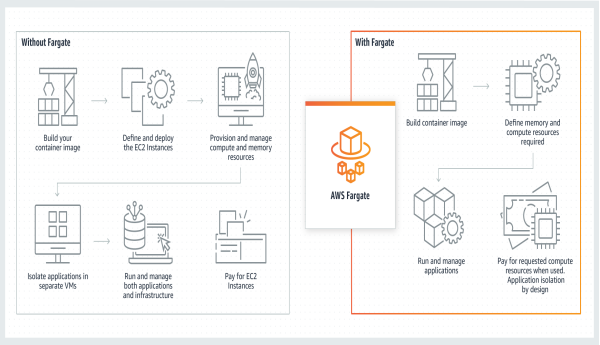An ergonomic assessment also called an ergonomic risk assessment, is an objective measure of the risk factors in your work environment that may lead to musculoskeletal disorders or injuries among your workforce, so that you can make measurable improvements in the work environment. This article describes how to use AWS Fargate serverless deployment platform to host and execute a Machine Learning computer vision model based on Google’s Media Pipe platform. The objective is to calculate human body angles from the pose points and assess their posture ergonomically to see if there is any strain on the body. We have used industry-standard RULA (Rapid Upper Limb Assessment) assessment sheet to generate the risk score for the user’s posture.
AWS FARGATE
- AWS Fargate is a serverless compute engine for containers that work with both Amazon Elastic Container Service (ECS) and Amazon Elastic Kubernetes Service (EKS).
- Fargate removes the need to provision and manage servers, lets you specify and pay for resources per application, and improves security through application isolation by design.
- Fargate allocates the right amount of computing, eliminating the need to choose instances and scale cluster capacity.
- You only pay for the resources required to run your containers, so there is no over-provisioning and paying for additional servers.

MEDIAPIPE POSE
Media Pipe Pose is a Machine Learning model for high-fidelity body pose tracking. It infers 33 two-dimensional landmarks on the whole body (or 25 upper-body landmarks) from RGB video frames utilizing BlazePose research.
OBJECTIVE
- The objective of the Media Pipe poses estimation project is to detect the pose points of a given image and to calculate the heights of the elbow, knee, hip, etc.
- The landmark model in Media Pipe Pose comes in two versions: a full-body model that predicts the location of 33 pose landmarks (see figure below), and an upper-body version that only predicts the first 25.

RULA (Rapid Upper Limb Assessment)
RULA was developed to evaluate the exposure of individual workers to ergonomic risk factors associated with upper extremity MSD. The RULA ergonomic assessment tool considers biomechanical and postural load requirements of job tasks/demands on the neck, trunk, and upper extremities. A single-page worksheet is used to evaluate required body posture, force, and repetition. Based on the evaluations, scores are entered for each body region in section A for the arm and wrist, and section B for the neck and trunk. After the data for each region is collected and scored, tables on the form are then used to compile the risk factor variables, generating a single score that represents the level of MSD risk.

The following are the steps for RULA Assessment
Step 1: Locate Upper Arm Position
Step 2: Locate Lower Arm Position
Step 3: Locate Wrist Position
Step 4: Locate Wrist Twist
Step 5: Look up Posture Score in TABLE A
Step 6: Add Muscle Use Score
Step 7: Add Force/Load Score
Step 8: Find Row in Table C
Step 9: Locate Neck Position
Step 10: Locate Trunk Position
Step 11: Locate Legs
Step 12: Look up Posture Score in TABLE B
Step 13: Add Muscle Use Score
Step 14: Add Force/Load Score
Step 15: Find Columns in Table C
OVERVIEW OF PROJECT

ANGLE MEASUREMENT
- The pose points are fetched and stored in a list according to the profile (full front, right, left)
- The angles (left elbow, right knee, etc.) are calculated for the input image.
- The angles are stored in a dictionary.
- We get the output of the image with angles on it.
CONCLUSION
Thus, this article demonstrates the Efficient, on-demand, scalable, and cost-effective method of deploying the Google MediaPipe model in AWS Fargate’s serverless cloud.
YouTube Video demo
 Written By:
Written By:
Varshnidevi B
A passionate and hardworking individual with an aim to leverage my skills in the field of data science. Self-directed and a quick learner of new technologies.
 Written By:
Written By:
KARTHICK ARAVINDAN S K
I’m a data enthusiast person with a focus on Artificial Intelligence and SaaS product development. I’m hardworking, diligent, and dedicated – all qualities I put forward in everything I do.

